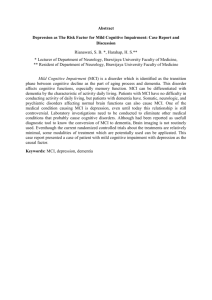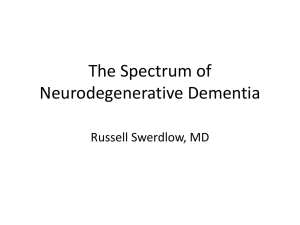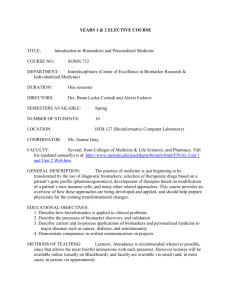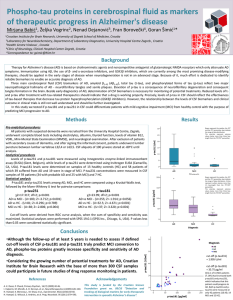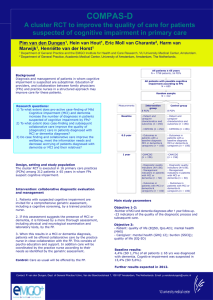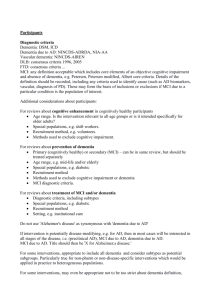MCI Criteria - Alzheimer's Association
advertisement
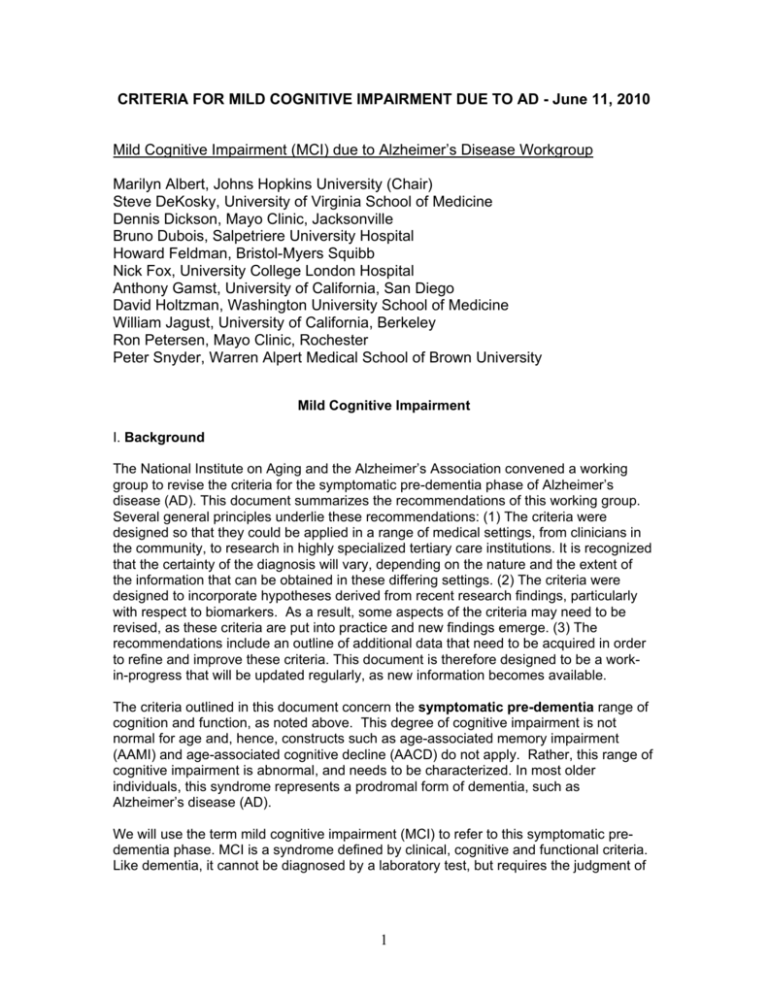
CRITERIA FOR MILD COGNITIVE IMPAIRMENT DUE TO AD - June 11, 2010 Mild Cognitive Impairment (MCI) due to Alzheimer‟s Disease Workgroup Marilyn Albert, Johns Hopkins University (Chair) Steve DeKosky, University of Virginia School of Medicine Dennis Dickson, Mayo Clinic, Jacksonville Bruno Dubois, Salpetriere University Hospital Howard Feldman, Bristol-Myers Squibb Nick Fox, University College London Hospital Anthony Gamst, University of California, San Diego David Holtzman, Washington University School of Medicine William Jagust, University of California, Berkeley Ron Petersen, Mayo Clinic, Rochester Peter Snyder, Warren Alpert Medical School of Brown University Mild Cognitive Impairment I. Background The National Institute on Aging and the Alzheimer‟s Association convened a working group to revise the criteria for the symptomatic pre-dementia phase of Alzheimer‟s disease (AD). This document summarizes the recommendations of this working group. Several general principles underlie these recommendations: (1) The criteria were designed so that they could be applied in a range of medical settings, from clinicians in the community, to research in highly specialized tertiary care institutions. It is recognized that the certainty of the diagnosis will vary, depending on the nature and the extent of the information that can be obtained in these differing settings. (2) The criteria were designed to incorporate hypotheses derived from recent research findings, particularly with respect to biomarkers. As a result, some aspects of the criteria may need to be revised, as these criteria are put into practice and new findings emerge. (3) The recommendations include an outline of additional data that need to be acquired in order to refine and improve these criteria. This document is therefore designed to be a workin-progress that will be updated regularly, as new information becomes available. The criteria outlined in this document concern the symptomatic pre-dementia range of cognition and function, as noted above. This degree of cognitive impairment is not normal for age and, hence, constructs such as age-associated memory impairment (AAMI) and age-associated cognitive decline (AACD) do not apply. Rather, this range of cognitive impairment is abnormal, and needs to be characterized. In most older individuals, this syndrome represents a prodromal form of dementia, such as Alzheimer‟s disease (AD). We will use the term mild cognitive impairment (MCI) to refer to this symptomatic predementia phase. MCI is a syndrome defined by clinical, cognitive and functional criteria. Like dementia, it cannot be diagnosed by a laboratory test, but requires the judgment of 1 a clinician. Also like dementia, MCI may be due to one or more etiologies. The criteria outlined below focus on identifying individuals with „MCI due to AD‟. These criteria incorporate the concept that, prior to the time an individual becomes demented, it may be possible to identify those individuals with AD pathology as the primary cause of their progressive cognitive dysfunction. The term „MCI due to AD‟ has been used throughout this document to reflect that underlying assumption. II. Clinical Criteria for the Diagnosis of MCI due to AD In this section we outline the criteria for the clinical and cognitive syndrome of individuals with „MCI due to AD‟. In considering the specifics of this clinical and cognitive syndrome, it is important to emphasize that sharp demarcations between normal cognition and MCI, and between MCI and dementia are difficult, and clinical judgment must be used to make these distinctions. A. MCI – Criteria for the Clinical and Cognitive Syndrome: 1. Concern regarding a change in cognition There should be evidence of concern about a change in cognition, in comparison to the person‟s prior level. This concern can be obtained from the patient, from an informant who knows the patient well, or from a skilled clinician observing the patient. 2. Impairment in one or more cognitive domains There should be evidence of lower performance in one or more cognitive domains that is greater than would be expected for the patient‟s age and educational background. If repeated assessments are available, then a decline in performance should be evident over time. This change can occur in a variety of cognitive domains, including: memory, executive function, attention, language and visuospatial skills. An impairment in episodic memory (i.e., the ability to learn and retain new information) is seen most commonly in MCI patients who subsequently progress to a diagnosis of AD. (See the section on the cognitive characteristics, below, for further details). 3. Preservation of independence in functional abilities Persons with MCI commonly have mild problems performing complex functional tasks they used to be able to perform, such as paying bills, preparing a meal, shopping at the store. They may take more time, be less efficient, and make more errors at performing such activities than in the past. Nevertheless, they generally maintain their independence of function in daily life, with minimal aids or assistance. 4. Not demented These cognitive changes should be sufficiently mild that there is no evidence of a significant impairment in social or occupational functioning. It should be emphasized that the diagnosis of MCI requires evidence of intra-individual change. If an individual has only been evaluated once, change will need to be inferred from the history and/or evidence that cognitive performance is impaired beyond what would have been expected for that individual. Serial evaluations are of course optimal, but may not be feasible in a particular circumstance. 2 B. Cognitive Characteristics of MCI Due to AD It is important to determine if there is objective evidence of the reports by the individual and/or an informant of cognitive decline and, if so, the degree of this decline. Cognitive testing is optimal for objectively assessing the degree of cognitive impairment for an individual. Scores on cognitive tests for individuals with MCI are typically 1-1.5 standard deviations below the mean for their age and education matched peers on culturally appropriate normative data (i.e., for the impaired domain(s)), when available. It is emphasized that these ranges are guidelines and not cutoff scores. 1. Cognitive Assessment As noted above, an impairment in episodic memory (i.e., the ability to learn and retain new information) is most commonly seen in MCI patients who subsequently progress to a diagnosis of AD. Research studies have shown that there are a variety of episodic memory tests that are useful for identifying those MCI patients who have a high likelihood of progressing to AD dementia within a few years. These tests share the characteristic that they assess both immediate and delayed recall, so that it is possible to determine retention over a delay. Many, though not all, of the tests that have proven useful in this regard are word list learning tests with multiple trials. Such tests reveal the rate of learning over time, as well as the maximum amount acquired over the course of the learning trials. They are also useful for demonstrating that the patient is, in fact, paying attention to the task on immediate recall, which then can be used as a baseline to assess the relative amount of material retained on delayed recall. Examples of such tests include (but are not limited to): the Free and Cued and Selective Reminding Test, the Rey Auditory Verbal Learning Test, and the California Verbal Learning Test. Other episodic memory measures include: delayed recall of a paragraph such as the Logical Memory I and II of the Wechsler Memory Scale Revised (or other versions) and immediate and delayed recall of non-verbal materials, such as the Visual Reproduction subtests of the Wechsler Memory Scale-Revised I and II. Since other cognitive domains can be impaired among MCI patients, it is important to examine domains in addition to memory. These include: executive functions (e.g., setshifting, reasoning, problem-solving, planning), language (e.g., naming, fluency, expressive speech and comprehension), visuospatial skills, and attentional control (e.g., simple and divided attention). Many validated clinical neuropsychological measures are available to assess these cognitive domains, including (but not limited to): the Trail Making Test (executive function), the Boston Naming Test, letter and category fluency (language), figure copying (spatial skills) and digit span forward (attention). If formal cognitive testing is not feasible, then cognitive function can be assessed using a variety of simple, informal techniques. For example, the clinician can ask a patient to learn a street address and to recall it after a delay interval of a few minutes (e.g., John Brown, 42 Market Street, Chicago). Alternatively, the clinician can ask the patient to name three objects (e.g., a pen, a paper clip and a dollar bill), place them in differing locations around the room and subsequently ask the patient to recall the names of the objects and their locations, again after a brief delay. These types of approaches are relatively easy to perform during an office visit, and will yield informative results. It is important, though, for clinicians to recognize that these informal bedside tests will likely be insensitive to subtle cognitive dysfunction during the early stages of MCI, and will often yield normal performance. 3 Finally, it must be recognized that atypical clinical presentations of Alzheimer‟s disease may arise, such as the visual variant of Alzheimer‟s disease (involving posterior cortical atrophy), and these clinical profiles are consistent with the presence of AD neuropathology. 2. Summary of Clinical and Cognitive Evaluation The initiation of a clinical and cognitive evaluation typically includes a cognitive concern expressed by the patient, an informant or a clinician observing the patient‟s performance. Cognitive decline can be documented by means of the history from the patient, preferably corroborated by an informant, or on the basis of observation by the clinician. Ideally, if serial assessments are available, they would be preferable, but in the setting of a single evaluation, this information is inferred from the history. The patient‟s cognition is assessed and found to be outside the normal range of function for the patient‟s age and educational background, but not sufficiently impaired to constitute dementia. The impairment can involve one or more cognitive domains. The clinician determines if memory is prominently impaired, or if impairments in other cognitive domains predominate, such spatial or language impairment. Typically, memory is the most common domain involved among patients who subsequently progress to AD dementia, as noted above. There is generally mild functional impairment for complex tasks, but basic activities of daily living should be preserved, and the person does not meet criteria for dementia. 3. Longitudinal Cognitive Evaluation Evidence of progressive decline in cognition provides additional evidence that the individual has „MCI due to AD‟, as noted above. Thus, it is important to obtain longitudinal assessments of cognition, if possible. It is recognized that a diagnosis will likely need to be given without the benefit of this information. However, establishing evidence of progressive declines in cognition over time is important for establishing the accuracy of the diagnosis. 4. Cautionary Issues Pertaining to Cognitive Assessment It is important to emphasize that virtually all cognitive tests are sensitive to differences in age, education (i.e., literacy) and cultural variation among individuals. Age and educational norms are available for some tests, but few have norms that pertain to the oldest old (individuals over 85 years of age). Moreover, considerable work remains to establish the reliability of cognitive tests across populations with wide cultural variation. C. Etiology of the MCI Clinical and Cognitive Syndrome Consistent with AD Once it has been determined that the clinical and cognitive syndrome of the individual is consistent with that associated with AD, then the clinician must determine the likely etiology, e.g., degenerative, vascular, depressive, traumatic or related to contributing medical co-morbidities. Typically, this information is derived from the history and ancillary testing (e.g., neuroimaging, laboratory studies and neuropsychological assessment) that may prove informative. For a diagnosis of „MCI due to AD‟, it is necessary to rule out other systemic or brain diseases that could account for the decline in cognition (e.g., vascular, traumatic, medical). This diagnostic strategy is similar to the one that is used to make a diagnosis of „dementia due to AD‟. This may include seeking evidence for: (1) Parkinsonism, prominent visual hallucinations, and REM abnormalities, often seen in Dementia with 4 Lewy Bodies, (2) multiple vascular risk factors and/or the presence of extensive cerebrovascular disease on structural brain images, which is suggestive of vascular cognitive impairment, (3) prominent behavioral or language disorders early in the course of disease that may reflect Frontotemporal Lobar Degeneration, or (4) cognitive decline that occurs over weeks or months, typically indicative of prion disease, neoplasm or metabolic disorders. It should be noted that the pathological features of some of these disorders can exist in combination with AD (e.g., Lewy Bodies and vascular disease), particularly among individuals at an advanced age. 1. Role of Genetics An additional issue is the role of genetics in the diagnosis. If an autosomal dominant form of AD is known to be present (i.e., mutation in APP, PS1, PS2), then the development of MCI is most likely the prodrome to AD dementia. The large majority of these cases develop early onset AD (i.e., onset below age 60). There remains, however, variable certainty about the time course over which the progression from MCI to AD will evolve in these individuals. In addition, there are genetic influences on the development of late onset AD. To date, the presence of an ε4 allele in the APOE gene is the only gene broadly accepted as increasing risk for late-onset AD, while the ε2 allele decreases risk. Evidence suggests that an individual who meets the clinical, cognitive and etiologic criteria for MCI due to AD, and is also ApoE-4 positive, is more likely to progress to AD within a few years than an individual without this genetic characteristic. It has been hypothesized that many additional genes may play an important, but smaller role than APOE, in increasing risk for AD. III. Biomarkers in MCI In this section we discuss the use of biomarkers in the diagnosis of MCI due to AD. Much has been learned about the application of biomarkers to individuals with MCI. It therefore seems important to incorporate this knowledge into the diagnostic framework outlined here, recognizing as noted above, that as new information emerges, it may be necessary to revise the way in which these recommendations incorporate biomarkers. Two fundamental questions about MCI patients may be answered by the use of biomarkers. The first is the definition of the underlying etiology of MCI, which will have major importance for choosing the correct therapy, when effective treatments are available. The second is the determination of the likelihood of cognitive and functional progression for an individual MCI patient to a more severe stage of MCI or to dementia, and the likelihood that this progression will occur within a defined period of time. These questions are clearly interdependent, as different underlying etiologies can confer different prognoses for progression. However, a biomarker that is useful for defining an etiology may or may not be useful for prognostication, and vice versa. The different properties of biomarkers will drive their use in clinical situations, such as deciding whom to treat, as well as research situations that might include selection of subjects for clinical trials or for inclusion in longitudinal research studies. In addition, because the timing of progression to dementia is important, different biomarkers may have differential utility over the short- and long-term. 5 Biomarkers may be divided into several different classes. Some biomarkers directly reflect the pathology of AD by providing evidence of the presence of key proteins deposited in the brain during the course of AD. Other biomarkers provide less direct or non-specific evidence of AD by tracking a variety of indices of neural failure or loss that are “downstream” from the molecular pathology. These latter biomarkers may also have some specificity for AD, by virtue of the regional pattern of abnormalities. Conversely, other patterns can be useful in providing evidence of a non-AD underlying cause. Still other biomarkers reflect biochemical changes related to processes such as cell death, oxidative stress or inflammation that may be part of the cascade of events that mediate damage, or the response to damage, in AD. The major biomarkers in each of these categories are discussed below and listed in Table 1. A. Biomarkers Reflecting Molecular Neuropathology The fundamental plaque and tangle pathology of AD is reflected in biomarkers that can detect and quantify the relevant proteins that accumulate in the brain, Aß and tau. These proteins can be measured directly in CSF and serum; however, their levels in CSF directly reflect the presence/amount of cerebral Aβ deposits (e.g., lower Aβ-42) and neurodegeneration/neurofibrillary tangles (e.g., raised CSF tau and phosphorylated tau, or p-tau). PET scanning with a variety of ligands, some of which are still under development, can also detect fibrillar Aß. CSF Aβ-42 and PET measures of fibrillar Aß are strongly, inversely correlated and appear to reflect Aβ deposition in the brain. It is likely that Aβ and tau measures provide different sorts of information, as current evidence suggests that changes in CSF Aß42 precede changes in tau during the progression of AD pathology. CSF Aß-42 and tau measures, the ratio of CSF tau/Aβ42, and PET amyloid measures, have been shown to predict conversion of MCI patients to dementia. Whether one of these measures or a combination of them is more sensitive than the other, and whether quantitative values provide more information than a dichotomous rating are yet to be determined conclusively. Detection of a molecular biomarker reflecting AD pathology in an individual with MCI has two implications, depending on whether their levels fall within a range that supports the diagnosis of „MCI due to AD‟. First, if therapies directed at one or both of these two pathological proteins are being tested, or are effective for AD, then their detection with these biomarkers should indicate appropriate patient selection and a likely therapeutic benefit. Second, detection of these biomarkers in studies to date indicates a higher rate of cognitive and functional progression in patients with MCI whose Aβ and tau biomarkers are positive, as compared to MCI patients whose biomarkers are negative. However, best predicting the actual rate of progression may also depend on the degree to which an individual expresses signs of downstream effects that may be reflected in CSF markers of tau as well as additional biomarkers less specific for the pathology and more specific as indicators of neural damage or dysfunction. It should also be noted that while substantial deposits of Aβ and tau are required for a pathological diagnosis of AD, changes in these molecular markers in CSF are seen in other disorders (e.g., amyloid angiopathy, prion disease). Thus, the application of biomarkers as part of the clinical evaluation should consider other potential disorders, based on the overall clinical presentation of the patient. B. Downstream Measures of Structural and Functional Change 6 AD results in a wide range of structural and functional changes in the brain that have diagnostic and prognostic value in dementia and MCI. Many of these changes reflect topographic specificity for the neural damage or dysfunction that occurs in AD. Particular patterns of sequential involvement are characteristic of AD as well. Examples include loss of hippocampal volume seen on MRI, and reduction of glucose metabolism or perfusion in temporoparietal cortex that may be detected with PET or SPECT scanning. While these biomarkers have been associated with the neuropathology of AD, they are probably less specific than biomarkers that directly reflect the molecular pathology. In addition to the specificity of the topography of neuronal loss or dysfunction, these markers provide evidence about the symptomatic stage of disease that may not be provided by molecular markers, as noted above. This is because these functional and structural measures, and especially their change over time, show better correlation with clinical disease severity and cognitive function than do the molecular measures. Other approaches include the use of structural and functional measures that reflect more complex patterns of tissue loss or metabolic loss obtained with imaging procedures. These measures may be derived from data-driven statistical approaches in which many different brain regions are evaluated simultaneously. In these cases, replication and generalizability of findings must be demonstrated in order to develop data that can be used at the level of individual subject prediction. Other techniques for which less data are currently available include diffusion tensor imaging (DTI), MR spectroscopy (MRS), functional MRI (fMRI), and resting BOLD functional connectivity. MRI perfusion has shown results similar to both SPECT/PET perfusion and PET metabolism, but available data are more limited. C. Associated Biochemical Change AD is characterized by numerous biochemical events including oxidative stress and inflammation. CSF, plasma, and imaging markers of these processes may provide information about specific pathways that are abnormal, and could also provide information suggestive of underlying pathology. Additional work in this area is needed to know how useful these markers will be. D. Limitations of Current State of Knowledge Regarding Biomarkers for AD Many studies have used biomarkers to predict cognitive decline or progression to dementia among MCI patients, and most of the biomarkers in the table below are reported to be valuable in this situation. However, there are several important limitations to current knowledge. Few biomarkers have been compared to one another in multivariate studies, and the use of combinations of biomarkers in studies has been limited. For this reason, it is currently difficult to understand the relative importance of different biomarkers when used together, and to interpret results when biomarker data conflict with one another. Equally important, there is a dearth of truly predictive studies at the individual subject level or in unselected populations. Many biomarker studies report differences between 7 „converters‟ and „stable‟ groups of subjects analyzed retrospectively (i.e., with subsequent knowledge of which subjects progressed to dementia). Few studies define a specific value for a biomarker or biomarkers and then prospectively test its predictive accuracy. Effective use of biomarkers in the clinical and research arena will require the ability to assign a likelihood of decline or progression to dementia in an individual person over a specific time interval through the use of a single or multiple biomarkers. Another major limitation is knowledge about the timing of decline or progression to dementia, since the ability to detect change is dependent upon the period of observation or prediction. Some biomarkers appear to have utility in predicting change over relatively short periods of observation, such as over 1-3 years. It seems likely that other types of biomarkers would be useful in predicting change over longer periods of time, such as many years or even decades. A full understanding of the role of biomarkers in prediction of decline in MCI will require both short and long-term periods of observation. Lastly, little is known about outcome when biomarkers provide conflicting results, as noted above. When a panel of biomarkers is used, it is likely that for some individuals, one biomarker will be positive, one negative and one equivocal. This is complicated further by the fact that the biomarkers examined to date are not always clearly positive or clearly negative, but vary in degree. The long term significance of such findings may also vary with the length of follow-up. Table 1. Biomarkers Under Examination for AD Biomarkers of Molecular Neuropathology of AD CSF Aβ-42 CSF tau / phospho-tau PET amyloid imaging Downstream Measures of Structural Change Hippocampal Volume or medial temporal atrophy volumetric measures or visual rating Rate of brain atrophy Less well validated biomarkers: Diffusion tensor imaging (DTI), voxel-based and multivariate measures Downstream Measures of Functional or Metabolic Change FDG-PET imaging SPECT perfusion imaging Less well validated biomarkers: fMRI activation studies, resting BOLD functional connectivity, MRI perfusion, MR spectroscopy Associated Biochemical Change Inflammatory biomarkers Oxidative stress (isoprostanes) Other markers of synaptic damage and neurodegeneration such as cell death E. Application of Biomarker Criteria to the Clinical Diagnosis of MCI due to AD 8 While MCI has a variety of etiologies, our understanding of „MCI due to AD‟ is the most advanced because of the biomarker and clinical-pathological studies available. The conjoint application of clinical criteria and biomarkers can result in various levels of certainty that the MCI syndrome is due to AD pathology. For the purposes of the diagnostic scheme we propose here, two categories of biomarkers have been the most studied and applied to clinical outcomes. In this document they are abbreviated as “molecular” (which includes CSF Aß42, CSF tau/ Aß42 ratio, p-Tau/ Aß42 ratio or PET amyloid imaging) and “topographic” (which refers to hippocampal or medial temporal lobe atrophy on MRI, and temporoparietal/precuneus hypometabolism or hypoperfusion on PET or SPECT). The criteria outlined below incorporate the hypothesis that the biomarkers that „reflect the molecular neuropathology‟ of AD, increase the certainty that the pathology of AD is present. Conversely, if these molecular biomarkers are negative, this may provide information concerning the likelihood of an alternate diagnosis. It is recognized that biomarker findings may be contradictory and that much remains to be learned about the outcome in these situations. These biomarkers must be interpreted in light of well-established normative values that currently may vary from laboratory to laboratory. “Positive” or abnormal values should fall within reliable and valid pathological ranges. Procedures for acquisition and analysis of samples and data are also extremely important in implementing these biomarker criteria. In addition, while we consider biomarkers as “negative” or “positive” for purposes of classification, it is recognized that varying severities of an abnormality may confer different likelihoods or prognoses; this is currently difficult to quantify accurately for broad application. F. Biomarkers and Levels of Certainty for the Diagnosis of MCI due to AD When the clinical and cognitive syndrome of MCI, with an episodic memory disorder and a presumed degenerative etiology, has been established, the most likely cause is a neurodegenerative process such as AD. However, the eventual outcome still has variable degrees of certainty. The likelihood of progression to AD dementia will vary with the severity of the cognitive decline and the nature of the evidence suggesting that AD is the underlying cause. Positive biomarkers reflecting downstream measures of structural or functional change increase the likelihood that progression to dementia will occur within a few years. However, positive findings from a biomarker that reflects the molecular neuropathology of AD will confer the strongest support that the etiology is AD. We anticipate that this probabilistic framework will evolve as more information is obtained about AD biomarkers. For example, MCI patients that present with executive, spatial or language impairments may also progress to AD, though with a lower frequency. Nevertheless, these forms of MCI need to be recognized. The role of biomarkers may be particularly useful in this setting. For example, if a patient presents with a prominent visuospatial deficit and has significant atrophy in the parieto-occipital region on MRI, one might suspect a degenerative etiology likely leading to posterior cortical atrophy or the visual variant form of AD. If further positive evidence were obtained on the basis of amyloid imaging or cerebrospinal fluid markers for AD, then the case for „MCI due to AD‟ could be made. 9 In those MCI subjects whose clinical and cognitive MCI syndrome is consistent with AD as the etiology, biomarkers may affect levels of certainty in the diagnosis. Below we describe a hypothetical framework by which biomarkers may be used to increase diagnostic accuracy: 1. Biomarkers that strongly support the probability that the MCI syndrome is due to AD (a) A positive molecular biomarker and a positive topographic biomarker. The evidence to date indicates that this confers the highest likelihood of underlying AD. In addition, individuals with this biomarker profile are most likely to decline or progress to dementia due to AD in relatively short periods of time (b) A positive molecular biomarker and topographical biomarkers that are either normal or equivocal. Such individuals have evidence of brain Aβ deposition, and possibly neurodegeneration (increased tau), but no strong evidence for structural or functional abnormality. These individuals also have been shown to have a high likelihood of underlying AD but with a less certain likelihood of progression to dementia within a short period of time. 2. Biomarkers that suggest that the MCI syndrome is due to AD (a) A positive topographic biomarker in a situation in which molecular biomarkers have not been or cannot be tested. Since topographic biomarkers can be positive in a range of disorders, a positive topographic biomarker alone suggests an intermediate likelihood that the underlying cause is AD. It is recognized that for various reasons (primarily lack of access to the technology) it may be impossible to test subjects for molecular biomarkers. (b) A negative or ambiguous molecular marker with a positive topographical marker. In this case, an individual has been tested for molecular markers and the result is either indeterminate or definitely not within the pathological range, but a topographical biomarker suggests AD. In this situation, the likelihood is greater than in an individual with all negative biomarkers. 3. Biomarkers suggesting that the MCI syndrome has a low likelihood of being due to AD (a) Both molecular and topographical biomarkers are either negative or ambiguous. Such individuals may still have underlying AD, although the likelihood of this is considered low. 4. Biomarkers that suggest that the MCI syndrome is unlikely to be due to AD (a) Absent molecular biomarkers, and the presence of a biomarker suggestive of another, non-AD etiology of the MCI syndrome. Such biomarkers are not as well established as those for AD. They may include: (1) prominent frontal or fronto-temporal hypometabolism, hypoperfusion, or atrophy that often reflects Frontotemporal Lobar Degeneration, (2) loss of dopamine transporters seen with SPECT imaging, often seen in Dementia with Lewy Bodies, (3) a periodic EEG, diffusion weighted imaging changes on MRI, or an extremely high CSF tau protein in someone with very rapid dementia progression (progression from normal to moderate or severe dementia in 6 months or less) is typically indicative of prion disease, or (4) the presence of extensive cerebrovascular disease on structural brain images, without any biomarkers 10 characteristic of AD, which is suggestive that the syndrome may reflect vascular cognitive impairment. In all of these cases the risk of subsequent decline is related to the most likely underlying pathology and the potential treatments that may be available. IV. Proposed Terminology for Classifying Individuals with ‘MCI due to AD’ with Varying Levels of Certainty We propose the terminology below for „MCI due to AD‟, incorporating the use of biomarkers. It is fully recognized that there are limitations in our knowledge about these biomarkers, as noted above. These criteria are designed to stimulate the application of biomarkers in clinical and research settings, thus permitting refinements in these criteria over time. 1. MCI of a neurodegenerative etiology The criteria outlined above for MCI with a presumed degenerative etiology represents the typical presentation of individuals who are at an increased risk of progressing to AD dementia. As noted above, these individuals typically have a prominent impairment in episodic memory, but other patterns of cognitive impairment can also progress to AD dementia over time (e.g., visuospatial impairments). Note that negative or ambiguous biomarker evidence (from either topographic or molecular biomarkers) is still consistent with the possibility that the patient with MCI has underlying AD pathology. However, if the biomarkers are negative for AD neuropathology, the likelihood that the diagnosis is due to AD, as opposed to an alternate cause, is low. 2. MCI of the Alzheimer Type If the subject meets the MCI criteria above, but in addition, has one or more topographic biomarkers associated with the „downstream‟ effects of AD pathology (e.g., MRI evidence of medial temporal atrophy, or FDG PET evidence of decreased temporoparietal metabolism, adjusting for age), then there is increased likelihood that the outcome will be AD dementia. It should be noted that in the absence of molecular biomarker information (or equivocal findings from molecular biomarkers) is still consistent with an intermediate level of certainty that the individual will progress to AD dementia over time. 3. Prodromal Alzheimer’s Dementia If the subject meets the MCI criteria above, and in addition has a positive biomarker for the molecular neuropathology of the Alzheimer‟s disease, this provides the highest level of certainly that over time the individual will progress to AD dementia. This level of certainty would be increased even further if the individual has positive topographic biomarker evidence of AD. However, the absence of such topographic biomarker evidence (or equivocal or normal findings) is still consistent with the highest level of certainty that the individual will progress to AD dementia over time. 11
